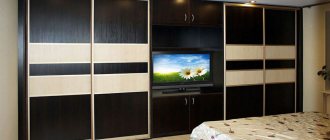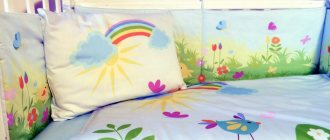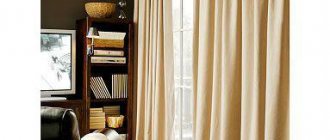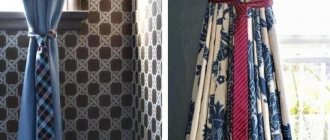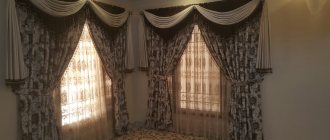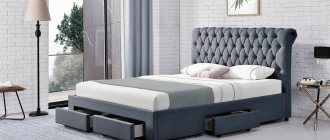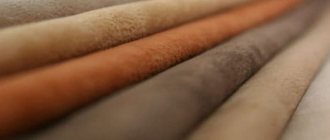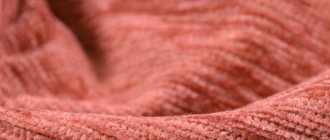Stylish and unusual wall decor with fabrics is a great way to create a special atmosphere in the living rooms of the house. This finishing option allows you to add zest to any design, make it stand out and make it as comfortable as possible for living. Work on decorating walls with fabrics should begin with the choice of materials. This applies to the type and quality of paintings, their colors. The appropriate color scheme, the presence of patterns or their absence will affect the possibility of completely or partially changing the interior. You also need to carefully study the information about fastening methods and choose the one that the owners can do with their own hands. Take into account the advice and instructions of specialists on the choice of fabrics, their fixation, rules for subsequent care, and you can easily transform your apartment and make it unique.
History of wall decoration with fabric
The use of fabrics for wall decoration dates back to Ancient Rome. Craftsmen made luxurious canvases from wool and linen, and painted with patterns. The widespread use of such materials arose in the 12th century in Western Europe. The so-called trellises were woven carpets that completely covered the walls. Of course, only representatives of the nobility could afford such luxury. Biblical motifs became the main theme of such fabrics. Later (around the 15th century) a completely new, eye-catching type of mille-fleur painting was created in Paris. Their main feature was the highlighting of a hero, plot, or animal in the center. The background of such fabrics was dark, and around the woven thematic center there were numerous small flowers and leaves. And in 1633, the Gobelin brothers created a large manufactory for the production of similar fabrics for decorating houses. Such paintings are still known today: they are familiar to us under the name tapestries. Their widespread use ceased after the emergence of paper wallpaper in the 18th century.
How to decorate chairs with fabric?
Of course, the drapery of the chairs should be in harmony in color and texture with the tablecloth. Usually, covers are sewn from the same fabric as for the table, which are then decorated. As decoration, you can choose bows of a contrasting shade or flowers.
However, it is quite possible to do without covers; there are much less expensive and time-consuming ways to decorate chairs with fabrics. For example, you can simply tie a wide textile ribbon around the back, and then decorate it with a flower arrangement or some bright pompom.
Option for decorating chairs with ribbons
Decorating chairs for a wedding with ribbon and flowers
Advantages and disadvantages
The main advantage of fabric wall decoration is the creation of a special homely atmosphere: even wooden decoration is unable to elevate the interior so much. Other advantages of decorating walls with fabrics include:
- the ability to create a general composition of finishing and identical upholstery of upholstered furniture;
- environmental friendliness of most materials;
- increased sound insulation of walls;
- high tissue resistance to mechanical damage;
- maintaining good vapor permeability of walls;
- quick installation without joints (or with just 1-2 joints on a long wall);
- the possibility of additional invisible sound insulation and insulation (although not feasible with all types of fabric fastening).
As for the disadvantages of such decoration, it is worth remembering: the fabric will collect dust and therefore will require frequent cleaning. Canvases in sunny rooms can quickly fade. The price of the material itself (even when attaching the fabric with your own hands) is quite high, and fixing the fabric near electrical points is quite a difficult job.
Banquet hall walls
You can, of course, cover the entire perimeter of the room with fabric, but most often only that part of the wall that is located behind the newly-made spouses is decorated. There are no limits to creativity and imagination here: make complex weaves of multi-colored fabrics, form them into all sorts of shapes, for example, swans, collect lush roses. You can complement the composition with balloons, LED garlands, fresh flowers, inscriptions, shiny rings imitating wedding rings, butterflies made of paper or cardboard.
Material selection
The best solution for decorating walls with fabric in residential premises is to choose special fabrics designed specifically for mounting as decoration. They are completely safe (painted with harmless paints), retain their brightness well for a long time, but are very expensive. Inexpensive options include furniture fabrics (jacquard, tapestry). The dense weave of the fabrics ensures lightness while maintaining integrity. Such fabrics fade slowly. An additional advantage is the creation of good sound insulation in the rooms. It is acceptable to use natural fabrics with a less dense weave and, accordingly, less wear resistance (linen, cotton and sisal in their pure form or with a small percentage of viscose). The use of such materials allows you to create a special coziness and guarantees environmentally friendly finishing of the premises. Light and translucent fabrics (taffeta, cambric) are least often used for interior decoration. They are suitable for decorating individual sections of walls.
On a note
Finally, take a few more useful tips on creating wedding decor with fabrics.
- Choose the material for decoration depending on the effect you want to achieve.
Airy fabrics (tulle, organza or chiffon) will add tenderness and lightness to the event, while denser, more expensive fabrics (velvet, satin, brocade) will add luxury.
- Remember that light shades visually expand the space, while dark shades, on the contrary, narrow it. Consider this fact when choosing colors for textiles.
- When choosing the color of fabric for a feast (tablecloths, napkins, chair covers), you should also take into account the shades of the dishes. White, gold and milky are universal and will suit absolutely any set.
- By the way, napkins are a detail not only for aesthetics and hygiene, but also for additional table decoration. You can use them to make elegant bows, flowers, swans, boats and many other interesting items.
- Before purchasing, calculate the required amount of material, purchase fabric with a small margin.
Presidium for newlyweds, decorated with fabric
- Be sure to ask the restaurant in advance what types of decorative fixtures you will be allowed.
- It would be useful to recall here that fabric is a highly flammable material. To ensure a holiday without any emergencies, carefully consider fire safety.
Presidium for newlyweds, decorated with fabric, with candles in glass candlesticks
Methods of fastening fabric
When choosing a fastening method, you must take into account the complexity of the work. If anyone can do the papering of a wall and stretching the fabric onto a strong frame, then it is almost impossible to do neat drapery or upholstery with your own hands without skills. In addition, in any of the methods of fixing the canvases, 1-2 assistants are needed. Correctly leveling or lifting the fabric can only be done when decorating a small section of the wall. To decorate an entire room, one pair of hands is simply not enough. Also pay attention to the complexity of preparation for work: some methods require perfect alignment of the wall. Otherwise, it will be impossible to achieve a neat fit of the fabric.
If you need additional insulation and soundproofing of the room, choose a mounting method in which auxiliary materials can be placed under the fabric.
Fabric stretching
To stretch the fabric onto the wall you will need: slats (nailed along the perimeter of the wall), small nails or a furniture stapler (for fastening the fabric), a piece of fabric (the size is determined by the size of the wall + 3-4 extra cm along all edges for fixing), a building level, dowels The operating procedure is as follows:
- The locations of the slats along the perimeter of the wall are marked under the level. They must be positioned strictly parallel so that the surface of the canvas is not overtightened.
- The fabric is carefully trimmed (it should be a perfect rectangle or square).
- The slats are fixed with dowels to the wall.
- The fabric is folded twice by 1.5-2 cm at the top. Then it is tacked with small nails or furniture staples to the top rail.
- The fabric is stretched to the bottom rail, folds are also made at the bottom and the fabric is fixed. Similar fastening is carried out on the sides.
A layer of sound insulation or insulation can be fixed under the stretched fabric. They are attached directly to the wall.
Gluing fabric
To glue the fabric, you will need the following tools and materials: a piece of fabric for decoration (for a long wall you can use 2 cuts), putty, spatula, paper, glue for paper wallpaper, fine sandpaper, furniture glue, iron, small nails and slats. The gluing work is carried out according to the following scheme:
- The fabric is checked for deformation: a small piece of it should be wetted and dried. If it has decreased in size, then the selected section is completely wetted, dried and smoothed. This will prevent the fabric from shrinking in the future.
- The wall is cleaned with a spatula and, if necessary, leveled with putty. Glue for paper wallpaper is applied to the wall and the paper is glued, which after drying is rubbed with sandpaper. If stains appear on the wall, you need to treat these areas with nitro varnish.
- The wall is covered with furniture varnish, the stretched fabric is carefully glued from top to bottom (work for two people), leveled, and ironed to harden the glue. Additionally, it can be padded on top with slats and nails for the most accurate fixation. They can be removed after 6-12 hours. Excess fabric is trimmed and the edges are treated with glue.
- After 3 days, if there are bumps, you need to break through each of them and go through the iron again. You can install skirting boards and baguettes at the top and bottom.
Drapery
To properly drapery a wall with your own hands you will need: self-tapping screws, a strip (equal to the length of the wall), a piece of fabric (2-3 times longer than the length of the wall and 10-15 cm longer than its height), small nails, building level. The work of fixing the canvas is carried out as follows:
- At the top, the location of the leveling slats is marked. The wall is cleared of debris and dust: there is no need to level the surface.
- The fabric is tucked 3-4 cm under the rail on the left and secured to it with the first nail from underneath. In this case, the fabric should have an allowance at the top of 5-7 cm. After 10-15 cm, a fold is formed along the length of the cut; it is fixed under the rail (on the back side) with a nail. Similar work is done until the end of the cut. On the right, its edge is also tucked under the bottom of the rail and fixed.
- The rail with the collected fabric is fixed according to the established markings. Fastening is carried out with self-tapping screws from the front part (that is, the nail heads will be located on the wall side). In the lower part, the fabric is folded 2 times and carefully grabbed or, according to a similar scheme, fixed on another rail.
When using a lath at the bottom, it is very difficult to maintain an even wave and no deformation. Therefore, the best solution would be to fix the canvas only on the top bar.
Upholstery
Upholstery is one of the most labor-intensive and complex ways to decorate walls. For work you need: a piece of fabric (length and width of the wall + 10 cm of margin on all sides), slats for the frame, dowels, small nails, spatula, putty, furniture glue and glue for heavy wallpaper, iron, thick insulation, building level. To cover the wall under the carriage screed, you need to do the following work:
- Clean the wall with a spatula and level the surface with putty.
- Make a drawing for the required upholstery pattern (with squares or diamonds). Mark the location of the slats below the level and then use dowels to secure these slats to the wall (without a frame, the finished decor will have insignificant volume, and all its luxurious appearance will be lost).
- Draw a similar drawing (exactly as the slats are located!) on whatman paper and make holes at the junction of the slats. Using the blank as a stencil, transfer these points onto the fabric.
- Glue thick insulation on top of the slatted frame with glue for heavy wallpaper.
- Glue the fabric on top of the wall above the slatted frame (1-2 cm higher) using furniture glue and iron it, additionally tack it with nails (then they can be removed). Stretch the fabric to the floor, and carefully moving from top to bottom, nail the material at the previously marked points. Thus, each point must clearly coincide with the intersection of the slatted frame located on the wall.
AH, MY GIRLFRIEND, SOFT PILLOW
In the old days, the number of pillows was strictly regulated.
Each bride was required to have at least six pillows in her dowry: four ordinary ones (for herself and her future spouse) and two small “thoughts” (for beauty). Now everything is determined by expediency and personal preferences. True, the bed looks more elegant if, in addition to the two main pillows, it also contains several decorative ones that match or contrast with the bedspread.
The main criterion when choosing pillows is their height, which should correspond to the natural curve of the spine. It all depends on the individual characteristics of a person’s constitution, so any advice is unnecessary.
Another thing is the filler. Here, perhaps, the most desirable options remain the “testaments of dear old times.” Down - duck and goose (for lovers of luxurious exotics - swan) - as if created by nature to fill pillows. It is soft, elastic, light. This pillow lasts for a long time without losing its wonderful properties, which to some extent compensates for its high cost.
The price for products with a mixture of down and feathers is slightly lower. True, they are stiffer, heavier and require a dense covering to hold the feathers where they are supposed to be. Well, the most affordable pillows in terms of price are feather ones.
Please note that pillows with natural filling have one common drawback: they can cause allergies. Moreover, the disease, as a rule, does not manifest itself immediately, but after several years, when microorganisms that cause allergies multiply in the pillow. Pillows with synthetic fill do not have this unpleasant feature. In addition, they can be washed repeatedly in an automatic machine. New generation fillers, such as Dacron, Britfil or polyester ball fiber, retain volume for quite a long time, although they are inferior in this to down and feather analogues. And the fragility of synthetic pillows is fully justified by their affordable price. Today you can also buy a pillow with “exotic” fillings, such as processed buckwheat husks, millet husks or juniper cones. They are excellent for the prevention of osteochondrosis, migraines, and also for normalizing blood pressure, as they relax the neck muscles and gently massage the occipital region. Pillows “filled” with millet, due to the presence of vitamin B and minerals in the latter, have a beneficial effect on the human body. And “buckwheat” pads do not wrinkle their hair, which is very important for women who want to look no worse in the morning than in the evening.
Buy pillows
Stylistic directions
You can decorate rooms in an original way using fabrics in completely different styles. The highlight is the use of fabric materials instead of conventional wallpaper. Fabric trim will look appropriate and beautiful in the following directions:
- Art Deco: for the direction it is recommended to select contrasting fabrics with large repeating patterns;
- modern: for styling in this direction, materials with abstractions, bright repeating patterns or special models with one large pattern (similar to photo wallpaper) are suitable;
- urban: for the style, plain fabrics of a light, soft color (or models with discreet patterns) will be preferable;
- ethnic style: fabrics with zigzag patterns of different colors are suitable for the direction;
- 50s style: bright fabrics with repeating flowing patterns will perfectly complement the direction;
- oriental: dark-colored materials with golden or silver patterns are suitable for the style;
- classic: an excellent solution would be to choose canvases with a dark background and eye-catching, repeating patterns and stripes.
Where is textile decor used at a wedding?
This question begs the answer: “Yes, anywhere, if you approach the design creatively and with imagination.” Most often they decorate with fabric:
- tables;
- chairs;
- stairs;
- stage;
- entrance to the hall;
- arches and columns;
- walls (especially the part behind the newlyweds).
Beach wedding and features of its design with fabric
Photo of wedding decoration with fabric
You can order decoration of the venue from professionals. In this case, several options will be offered, you can choose the most suitable one according to your taste and overall wedding concept. You can also take the decoration of the hall completely into your own hands, with the support of your loved ones - it’s not an easy task, but very interesting.
Wall decoration in the living room
In a spacious room, you can decorate the walls with fabrics in various ways. The most advantageous design options include:
- fabric decor for all living room walls;
You can glue the canvases or stretch them for each surface. In this case, it is allowed to use two materials of the same color scheme with different patterns (for example, decorate a couple of walls with a canvas with stripes, the rest with fabric with ornate patterns).
- allocation of a recreation area;
Behind the sofa and a couple of armchairs, intended for relaxing with friends and family leisure, you can place fabrics of any brightness and saturation (not contradicting the style and overall color scheme). Unusual decoration will give the room an original look, and at the same time will not distract the owners from relaxing.
- stylization of the wall located opposite the recreation area.
This design allows you to highlight the wall opposite the sofa and armchairs. For decoration, it is recommended to select fabrics with soft colors and discreet patterns or no patterns at all.
Necessary tools and consumables
Before starting work, you need to inspect the sofa or chair, find the fastening elements and focus on them when choosing a tool. You will definitely need: a screwdriver, pliers, a set of keys. It is worth preparing bags or bags for garbage. Scissors might come in handy. All this is needed to remove the old casing and, if necessary, carry out structural repairs.
In order to replace the upholstery of upholstered furniture, in addition to the materials that should be purchased in advance, you also need a stapler and staples. You will also need a hammer, since sometimes the staples do not fully penetrate the wood, they need to be hammered in additionally. A stapler is only suitable for construction; without it, it will not be possible to secure the fabric - without damaging the material, it firmly attaches it to the body. A tape measure, rulers and drawing tools will help in creating the pattern. For sewing you will need scissors, thread, and a sewing machine.
Only high-quality and durable threads should be used.
You can watch a master class to visualize how furniture upholstery changes; this will help you avoid certain mistakes. If you still have documentation for the product, it is better to use the drawings from it. It also contains instructions on how to assemble/disassemble the structure.
Criteria for choosing European covers for upholstered furniture, color range of covers
Screwdrivers and pliers
A set of keys
Stapler and staples
Measuring tools
Sewing supplies
Wall decoration in the bedroom
Unusual decoration of the bedroom with fabric trim allows you to emphasize its originality and comfort. The best options for using textiles in a living room include:
- highlighting the head of the bed;
Here, the usual gluing of fabric or complete draping of the wall is allowed. It will look unusual not to completely decorate the surface, but to highlight a rectangular area behind the headboard (although the fabric should slightly protrude beyond the headboard on the sides). You can also make a stylish niche with lighting, inside which fabric will be glued.
- allocation of a sleeping bed;
In this option, you can place a couple of strips of fabric on the sides of the bed (for example, behind the bedside tables). It will also look good when gluing or nailing canvases onto two walls near which the bed is located (that is, behind the headboard and to the left or right of the sleeping bed).
- highlighting the entrance or wall opposite the bed.
It will create special comfort and help the owners start every morning in a great mood.
Stage, arches and columns
Some architectural features of the room should be hidden , or, conversely, emphasized by decorating them with fabric.
For example, if the hall has columns, decorate them in any of the following ways:
- Drape only the top of the column;
- If two columns stand next to each other, connect them together with fabric to form an arch;
- Hang the material like a curtain and then pull it around the column in the middle;
- Wrap the column in a spiral from top to bottom.
If a stage is planned to be used during the event, special attention should be paid to it!
Just hanging curtains from the ceiling look boring and uninteresting; at a minimum, they need to be decorated with bows, balls or flowers. The fabric in the form of a silhouette of a bride in a fluffy dress also looks creative. To do this, you will need to pull the fabric in the middle or slightly lower (at the “waist”), stretch the bottom and fasten it - you will get a hem. And then it’s a matter of imagination: the head and arms are made using paper.
You can often see arches at weddings : these structures not only look solemn, but also symbolize heaven, that is, the blessing of a young family from above. Most often, their design also includes fabrics. The material for the arch must be light and light, like clouds; it can simply fall from top to bottom, sag slightly, or fit tightly around the frame.
Option for decorating an arch for a wedding with fabric and flowers
Wedding arch decorated with fabric and flowers
Arch decorated with fabric
Care instructions
Fabric trim must be cleaned dry. Any wetness of the surface can lead to the appearance of stains and stains on it. Therefore, you need to use a vacuum cleaner to carefully remove accumulated dust. You will need to purchase a special nozzle (with a soft coating) in advance, designed for cleaning furniture and various textile coverings. It will also help to maintain the original condition of the fabric trim by following these recommendations:
- When installing the air conditioner, keep in mind that dust particles carried by the flow will settle on the surface of the canvases. Therefore, it is not recommended to hang the air conditioner opposite a fabric wall or in a room with walls completely decorated with fabric.
- In sunny rooms, fabric fading should be prevented. Therefore, the decoration should be immediately placed on the walls, where the sun’s rays do not reach, or the windows should be covered with thick curtains during the period when the sun penetrates into the room.
- In rooms with fabric decoration it is necessary to maintain low air humidity. If necessary, installing a dehumidifier is recommended.
Textile wallpaper as an alternative to fabric finishing
Textile wallpaper can be a good substitute for gluing or stuffing fabric on walls. In appearance, they are somewhat similar to ordinary fabrics, but they are produced using a special technology: by gluing fabric or individual layers of fibers to a base. The base of the materials itself can be paper or non-woven. The first option has an affordable price, but the duration of maintaining the original appearance of such a finish is quite doubtful: a heavy canvas can last for many years or will soon begin to peel off. Textile wallpaper on a non-woven basis has a higher price, but also lasts longer. For additional protection, this type of finish can be coated with clear varnish or polymer film. This ensures minimal damage to materials and slow fading in the sun. But you need to stick textile wallpaper only on a perfectly flat wall. Despite the possibility of hiding irregularities with a structural finish, the presence of differences will lead to rapid peeling of the material.
UNDER THE BLANKET…
Despite
Although hygiene experts recommend maintaining a bedroom temperature of 16–18 °C, practice shows that sleep is sweeter if a person is wrapped up warmly.
Therefore, the choice of blanket should be approached rationally. In cold weather, you can’t do without a quilt filled with down and feathers: the ratio is 90% and 10% for the warmest products. But a ratio of 50:50 is undesirable, since the feather will very soon begin to pierce the fabric, and what kind of peaceful sleep is that? Unfortunately, the “down” option is not suitable for allergy sufferers, but today some manufacturers have begun to treat down and feathers with special anti-allergenic compounds. So the sleep of people susceptible to the disease will be restful.
Comparable in warmth to polyester fiber duvets. In addition, they can be washed at home and, unlike padding polyester, they do not become harder because of this. The polyester in these blankets can be fluffed or beaded. Their price is usually higher than that of cotton blankets, but lower than that of wool-filled blankets. And keep in mind an important thing - under such a blanket you will not be afraid of any allergies!
Traditionally, blankets made of camel or sheep wool are popular in our country - thin, light and warm. They tend to be good in the cooler months, while lighter blankets made from blended or cotton fabrics are suitable for the off-season and summer. It is a significant advantage if the manufacturer allows them to be washed at home, since many models only require dry cleaning. In general, for cotton products, the ideal weight can be considered 800 g for summer and 1500 g for winter. It is worth noting that the blanket should be chosen at least half a meter larger than the width of the bed, so that its edges go down the sides: it is more comfortable to sleep under and the bed looks more aesthetically pleasing.
Buy a blanket

